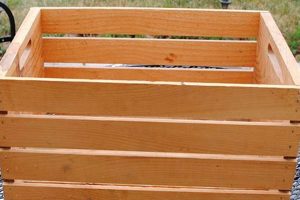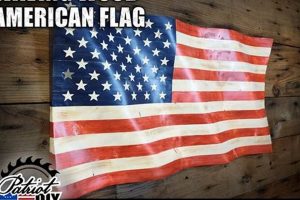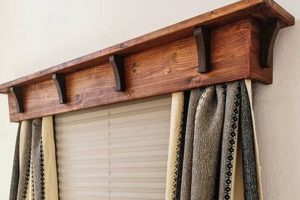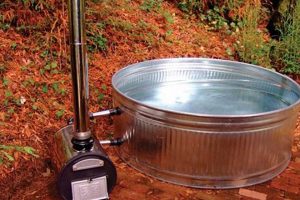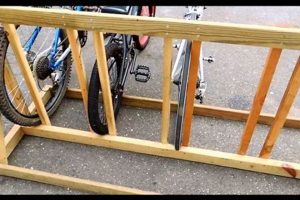A constructed background, typically used in photography or event decoration, built from wooden materials and assembled by the end-user. This construction allows for customization in size, design, and finish, contrasting with pre-fabricated or professionally installed alternatives. For example, planks of reclaimed lumber can be arranged to create a rustic photographic setting.
The appeal of creating these custom backgrounds stems from their cost-effectiveness and creative control. By assembling the structure, individuals can tailor the backdrop to specific aesthetic needs and budgetary constraints. Historically, similar backgrounds were often professionally built and costly, making them less accessible to amateur photographers and event organizers. The self-assembly option democratizes access to high-quality visual elements.
The following sections will explore various design options, construction techniques, material considerations, and finishing methods associated with the creation of such a personalized scenic element. Detailed information on safe construction practices and long-term maintenance is also included.
Construction Considerations
The following are essential guidelines for the successful design and construction of a self-assembled wooden background. Adherence to these recommendations will contribute to structural integrity and visual appeal.
Tip 1: Material Selection: Prioritize kiln-dried lumber to minimize warping and dimensional instability. Consider the aesthetic goals when choosing wood species; pine offers affordability, while hardwoods provide enhanced durability and visual texture.
Tip 2: Frame Construction: A sturdy frame is critical. Utilize screws rather than nails for superior holding power. Ensure square corners and consistent dimensions throughout the frame. A level surface is required during assembly to prevent racking.
Tip 3: Attachment Method: Select an appropriate attachment method for securing the wood panels to the frame. Screws offer a secure and easily reversible option. Countersinking screws and using wood filler will create a smooth surface for finishing.
Tip 4: Surface Preparation: Sand all surfaces to create a smooth and uniform texture. This step is crucial for achieving a professional-looking finish, regardless of whether the backdrop is painted, stained, or left natural.
Tip 5: Finishing Techniques: Select finishes that complement the wood species and intended aesthetic. Apply finishes in thin, even coats, allowing adequate drying time between coats. Consider the environment in which the background will be used; outdoor applications require weather-resistant finishes.
Tip 6: Design Considerations: Plan the layout of the wooden elements carefully. Consider patterns, spacing, and the overall visual impact. Using a scaled drawing or digital rendering can aid in visualizing the final product.
Tip 7: Safety Precautions: Always wear appropriate safety gear, including eye protection and respiratory protection, when cutting, sanding, and finishing wood. Work in a well-ventilated area to minimize exposure to dust and fumes.
Implementing these suggestions results in a stable, visually appealing, and long-lasting structure suitable for various applications. Careful planning and execution are key to achieving a professional result in a self-built project.
The succeeding sections will cover specific design styles and advanced construction techniques, building upon the fundamentals outlined above.
1. Wood Type
The selection of wood type directly influences the structural integrity, aesthetic appeal, and overall cost of a constructed background. Different wood species exhibit varying characteristics regarding density, grain pattern, workability, and resistance to environmental factors. For example, reclaimed wood imparts a rustic aesthetic and is often a cost-effective choice, but may require extensive preparation to ensure a smooth surface. Conversely, premium hardwoods offer superior durability and visual elegance but command a higher price point. The intended application of the background dictates the necessary performance characteristics of the wood.
Considering the specific requirements of the construction, for instance, a large backdrop intended for frequent transport necessitates a lightweight yet rigid wood type such as pine or poplar to minimize weight without compromising structural soundness. In contrast, a permanent installation might benefit from the robustness and longevity of hardwoods like oak or maple. Furthermore, the chosen wood type dictates the appropriate finishing techniques; certain woods accept stains and paints more readily than others, directly impacting the final visual outcome. Softwoods generally require a sealant or primer to prevent uneven absorption of finishes.
Therefore, the relationship between wood type and the resulting backdrop is critical. A strategic selection process, considering factors beyond mere aesthetics, will contribute to a finished product that is both visually appealing and functionally appropriate. Overlooking the material properties of the wood may lead to structural failures, aesthetic inconsistencies, or premature deterioration, thereby highlighting the importance of informed decision-making in the construction process.
2. Frame strength
The structural integrity of a wooden background is fundamentally dependent on the strength of its frame. The frame serves as the primary support, bearing the weight of the wood panels and resisting forces that could lead to deformation or collapse. Insufficient frame strength results in instability, making the backdrop unsuitable for its intended use. For example, a poorly constructed frame may warp under the weight of heavier wood types, compromising the aesthetic alignment of the panels. This illustrates a direct cause-and-effect relationship where frame weakness leads to practical and visual deficiencies in the final product.
Frame strength is also critical for portability and long-term durability. A robust frame withstands the stresses associated with transportation and repeated use, extending the lifespan of the background. Consider a portable wooden backdrop designed for frequent event setups; a frame constructed from lightweight materials with inadequate joinery would likely fail prematurely, requiring costly repairs or replacement. Conversely, a frame utilizing reinforced joints and durable lumber ensures the backdrop remains stable and functional over time. Further, the design of the frame impacts its resistance to external factors like moisture or temperature fluctuations. Properly sealed and treated frames resist warping or degradation, especially important for outdoor applications.
Ultimately, the achievement of a structurally sound and visually appealing wooden background is predicated upon the construction of a strong, well-engineered frame. Addressing frame strength requires careful material selection, precise joinery techniques, and consideration of the backdrop’s intended use and environmental conditions. Neglecting this fundamental aspect inevitably leads to compromised stability, reduced longevity, and an unsatisfactory final product, highlighting the practical significance of understanding and prioritizing frame integrity in the design and construction process.
3. Panel alignment
Panel alignment directly impacts the visual coherence of a constructed wooden background. Misaligned panels disrupt the intended aesthetic, introducing irregularities that detract from the overall appearance. In the context of photographic backgrounds, for instance, uneven panel placement can create distracting shadows or distort the focal point, hindering the effectiveness of the image. The precision of panel alignment, therefore, directly influences the professional or artistic quality of the finished product.
Achieving accurate alignment necessitates careful measurement, precise cutting of materials, and meticulous assembly techniques. Slight variations in panel dimensions or imprecise joining methods accumulate, resulting in noticeable deviations across the surface. Real-world examples of constructed backgrounds reveal that even minor discrepancies in panel alignment are readily apparent, particularly in designs featuring regular patterns or contrasting colors. Consequently, stringent quality control during the construction phase is essential. Methods such as using leveling tools, clamps, and consistent spacing techniques can mitigate the risk of misalignment.
Ultimately, the visual success of a self-assembled wooden background hinges on accurate panel alignment. While minor imperfections may be acceptable in certain rustic designs, a generally level and consistent surface is crucial for achieving a polished and professional aesthetic. Overlooking panel alignment undermines the overall visual impact, diminishing the intended value of the constructed piece. Therefore, a comprehensive understanding of alignment principles and diligent application of precise construction techniques are fundamental to achieving a satisfactory outcome.
4. Surface finish
Surface finish is inextricably linked to the overall aesthetic and functional performance of a self-assembled wooden background. It defines the tactile qualities, visual characteristics, and protective properties of the exposed wood surface. The selection and application of the surface finish directly influences the longevity, cleanability, and visual appeal of the project. For example, a raw, unfinished wood surface is susceptible to moisture damage, staining, and degradation from ultraviolet radiation. In contrast, a properly applied sealant or paint provides a protective barrier, extending the lifespan and preserving the visual integrity of the construction. The importance of surface finish stems from its role as the final layer of defense against environmental factors and its direct impact on the perceived quality of the backdrop.
The practical significance of understanding surface finishes becomes apparent when considering various applications. A photographic backdrop designed for indoor use may benefit from a matte finish to minimize glare and reflections. Alternatively, a backdrop intended for outdoor events requires a weather-resistant sealant to protect against moisture, sunlight, and temperature fluctuations. The type of wood also influences the choice of finish; softwoods typically require a primer to prevent uneven absorption of paints and stains, while hardwoods may benefit from oil-based finishes that enhance their natural grain patterns. Proper surface preparation, including sanding and cleaning, is paramount for achieving a smooth and uniform finish. Improper preparation can result in blemishes, uneven color distribution, and compromised adhesion.
In summary, surface finish is a critical component in the creation of a durable and visually appealing self-constructed wooden background. Its selection and application must align with the intended use, environmental conditions, and aesthetic goals of the project. Addressing challenges related to surface preparation, material compatibility, and application techniques ensures a long-lasting and aesthetically pleasing result, contributing significantly to the overall success of the endeavor.
5. Design aesthetic
The design aesthetic is a governing influence on the construction of a wooden background. It predetermines material selection, construction techniques, and finishing methods, directly shaping the final visual presentation. A rustic aesthetic, for example, necessitates the use of reclaimed wood, rough-sawn lumber, and distressed finishes. Conversely, a modern minimalist aesthetic demands smooth, uniform surfaces, clean lines, and the potential incorporation of geometric patterns. The chosen aesthetic, therefore, acts as a blueprint guiding every stage of the construction process. Without a defined aesthetic, the resulting background lacks visual cohesion, diminishing its impact and effectiveness. The aesthetic dictates whether the backdrop complements or clashes with the intended subject, whether it serves to enhance or distract.
Consider the specific application of a constructed background within a photography studio. A light and airy aesthetic, achieved through the use of painted white wood with shiplap detailing, creates a bright and neutral backdrop suitable for a wide range of subjects, from portraits to product photography. In contrast, a dark and moody aesthetic, using stained wood planks arranged in a herringbone pattern, is more suited for artistic or dramatic imagery. Furthermore, the chosen aesthetic influences the framing and lighting decisions. A visually busy aesthetic requires simpler compositions and controlled lighting to avoid overwhelming the subject, while a clean and minimalist aesthetic allows for more creative freedom in composition and lighting. Properly understanding the connection between intended aesthetic and its execution is crucial for the background’s utility.
In conclusion, the design aesthetic is not merely a superficial consideration but an integral determinant of a wooden background’s success. It dictates the choices made throughout the construction process, influencing visual impact and functional suitability. A comprehensive understanding of the design aesthetic, coupled with careful execution, is paramount for achieving a constructed background that effectively serves its intended purpose. Ignoring the aesthetic intent risks creating a product that fails to meet visual expectations, underscoring the fundamental role of aesthetic direction in achieving a well-crafted background.
6. Structural stability
Structural stability is a non-negotiable attribute of any self-assembled wooden background. It dictates the backdrop’s ability to withstand gravitational forces, external pressures, and the stresses associated with repeated use or transportation. A lack of stability results in a backdrop prone to collapse, warping, or component failure, rendering it functionally useless and potentially hazardous. The consequences of inadequate structural integrity range from minor aesthetic imperfections to catastrophic structural failures, depending on the design and intended application. This inherent risk elevates structural stability to a paramount design consideration. For instance, a large photographic backdrop intended for commercial use must adhere to stringent stability standards to ensure the safety of both equipment and personnel. Failure to meet these standards could lead to equipment damage, personal injury, or legal repercussions.
The practical significance of ensuring structural stability extends beyond immediate safety concerns. A stable backdrop maintains its intended form and alignment over time, preserving its aesthetic appeal and functional utility. This long-term performance is particularly relevant for backgrounds used in professional settings or frequently transported to different locations. Consider a backdrop used for wedding photography; the ability to withstand repeated setup, teardown, and transportation without compromising its structural integrity is essential for its continued use and professional value. Effective design strategies for enhancing structural stability include selecting appropriate lumber species, employing robust joinery techniques, and incorporating bracing or reinforcement elements. Inadequate design choices result in an unstable framework, shortening its lifespan and impacting its cost-effectiveness. Properly reinforced designs resist stress during transportation, especially in backdrops designed to be free standing without the use of support beams.
In summary, structural stability is not merely an optional enhancement but a core requirement for a successful wooden background project. Addressing stability concerns through appropriate material selection, robust construction techniques, and adherence to safety standards is critical. Neglecting structural stability leads to diminished functional performance, increased safety risks, and reduced long-term value, demonstrating the importance of its role within the design and construction of such a framework. Successful self-constructed backdrops must prioritize the structural integrity of the unit to allow it to perform to the intended purposes and standards.
7. Portability
Portability is a critical consideration in the design and construction of a self-assembled wooden background, significantly impacting its practicality and overall utility. The ability to easily transport and relocate the backdrop is often a primary driver in design choices, balancing convenience with structural integrity and aesthetic aspirations.
- Weight of Materials
The selection of wood species directly influences the overall weight. Lightweight woods like pine or poplar facilitate easier transport, particularly for single-person setup. However, these lighter materials may compromise structural rigidity compared to denser hardwoods, necessitating a trade-off between portability and durability. The weight also impacts the choice of hardware such as screws and bolts, as they can contribute additional weight.
- Modularity and Disassembly
Designing the backdrop for modularity enables disassembly into smaller, manageable components for transport. This approach requires careful consideration of joinery methods, opting for quick-release fasteners or easily detachable hardware. The trade-off is potential reduction in overall structural stability compared to permanently affixed designs and careful storage to ensure smaller hardware is not misplaced.
- Size and Dimensions
The overall size directly affects its ease of transport. Larger backdrops may require specialized vehicles or multiple individuals for handling. The design often involves segmenting a larger backdrop into smaller panels to maintain portability, affecting the aesthetic of seamlessness which must be carefully balanced.
- Carrying and Handling Solutions
Incorporating handles, carrying cases, or wheeled platforms significantly enhances transportability. Custom-built carrying solutions protect the backdrop from damage during transport. However, these additions contribute to the overall cost and may increase storage space requirements.
The interplay of these elements ultimately determines the feasibility of frequent relocation. Striking an effective balance between weight, modularity, size, and integrated carrying solutions enables individuals to leverage the cost-effectiveness and customization benefits of a self-assembled wooden background without sacrificing convenience. The degree to which a design prioritizes portability dictates its suitability for various applications, from on-location photography to event setups.
Frequently Asked Questions
The following addresses common inquiries regarding the design, construction, and maintenance of self-assembled wooden backgrounds, providing objective information to aid in informed decision-making.
Question 1: What wood species is most suitable for constructing a lightweight, portable backdrop?
Pine and poplar are often preferred for their low density, reducing the overall weight of the structure. These softwoods are relatively easy to work with but may require additional reinforcement for larger backdrops.
Question 2: How can the structural integrity of a wooden frame be maximized?
Utilizing screws instead of nails, employing corner braces, and selecting appropriately sized lumber based on the backdrop’s dimensions are critical. Proper joint construction is equally important.
Question 3: What steps can be taken to ensure panels are accurately aligned during assembly?
Employing a level surface, utilizing clamps to secure panels during attachment, and pre-drilling pilot holes minimize misalignment. Regular checks with a spirit level are recommended throughout the process.
Question 4: What type of finish provides the most durable protection for an outdoor wooden backdrop?
Exterior-grade polyurethane coatings offer superior resistance to moisture, ultraviolet radiation, and temperature fluctuations. Multiple coats are generally necessary for optimal protection.
Question 5: How does the choice of wood affect the suitability of different paint types?
Softwoods often require a primer to prevent uneven paint absorption. Oil-based paints generally provide better coverage and durability on wood surfaces, while latex paints offer easier cleanup and lower volatile organic compound emissions.
Question 6: How can the longevity of a wooden backdrop be extended?
Regular cleaning, prompt repair of any damage, and periodic reapplication of protective finishes contribute to extended lifespan. Proper storage in a dry, sheltered location is also crucial when the backdrop is not in use.
These points highlight best practices for constructing and maintaining these self-built structures, emphasizing the importance of careful planning and execution. Choosing quality materials and precise construction methods is also important.
The next section will cover advanced design considerations, including the integration of lighting and other decorative elements.
Conclusion
The preceding discussion has explored the multifaceted considerations involved in constructing a “diy wood backdrop.” From material selection and frame construction to surface finishing and aesthetic design, numerous factors influence the success and longevity of such a project. Emphasis has been placed on achieving structural stability, ensuring accurate panel alignment, and optimizing portability for diverse applications.
Ultimately, the construction of a wooden background represents a synthesis of practical skills and creative vision. By understanding the principles outlined, individuals can create cost-effective and highly customizable visual elements for photography, events, and other applications. Continued exploration of innovative design approaches and advanced construction techniques will undoubtedly expand the possibilities for creating visually compelling and structurally sound wooden backdrops in the future. The principles outlined here can significantly enhance the quality of finished work.



